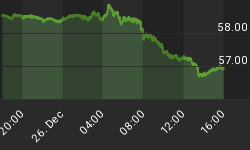The core PCE deflator for March recorded a near-record 1.1%. Should we worry that deflation is taking hold?
Well, first of all you should recognize that the PCE, unlike the CPI, is frequently revised and by significant amounts. As the chart below shows, this is only a near-record because there was a massive revision that raised the 2010 low from 0.7% or so to 1.1%. We should be wary, in my opinion, to draw any strong conclusions from (and certainly wary of implementing policy based on) a data series that can have the rate of change revised by 60%.
But still, core PCE is near its lows while core CPI is not. Should we be concerned about deflation? Should the Fed?
There are a number of reasons for the difference. A persistent difference of about 0.25%-0.5% is consistent with differences in the type of formula used and other "normal" differences. The Fed favors the PCE because it has a broader representation of the economy - in that it doesn't focus "just" on consumers - and because it adjusts more quickly as the composition of spending changes. However, if you are looking at how the costs to you the consumer change, the CPI is the index that you should be looking at.
The main reason that core PCE is currently so much lower than core CPI is that PCE has a much lower weight on housing. And, thanks to the Fed's loose money policy, it is housing that is driving the CPI higher. The difference in housing weights currently adds 0.31% to CPI compared to PCE. The PCE makes up for this low weight in housing by having a much higher weight on medical care (about three times the CPI weight). Why the huge difference in the medical care weight?
The CPI and PCE metrics are meant to measure different things - the PCE is broader, but the CPI measures specifically expenditures by consumers. Consequently, the difference in medical care weights occurs because the CPI measures spending by consumers, while the PCE includes spending by Medicare, Medicaid, other government entities, the employer portion of health insurance, and other non-consumer payers. Which do you think is more relevant for consumers? And which do you think is a better representation of what a typical consumer spends: 42% on housing and 6% on medical care, or 26% on housing and 22% on medical care? In simple terms, do you spend more for your house, or do you spend about equal amounts on both? I suspect that for most Americans, especially those who are employed and those who are currently receiving Medicare, spending on housing is vastly higher than direct spending on medical care.
Isn't it convenient for the Fed that right now, they can focus on a metric that is pointedly underweighting the category of expenditure that is most directly being affected by quantitative easing? This is one reason that I do not expect QE to stop any time this year.
You can follow me @inflation_guy!
Enduring Investments is a registered investment adviser that specializes in solving inflation-related problems. Fill out the contact form at http://www.EnduringInvestments.com/contact and we will send you our latest Quarterly Inflation Outlook. And if you make sure to put your physical mailing address in the "comment" section of the contact form, we will also send you a copy of Michael Ashton's book "Maestro, My Ass!"

















